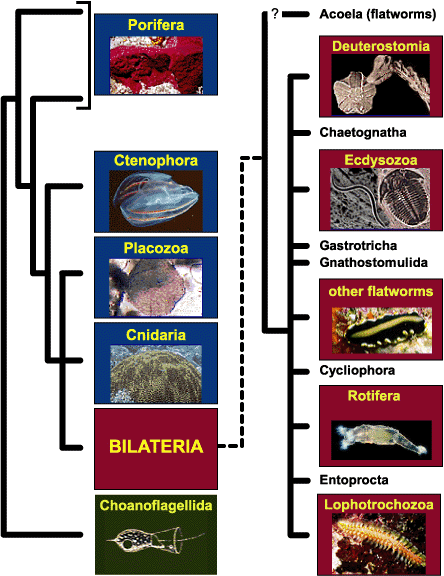Scientists care because
phylogeny is the
fundamental product of evolution. Therefore, a phylogenetic hypothesis
is essential if you want to understand biological phenomena, most of which
have an evolutionary explanation.
Since many scientists would like to know how animal diversity and
animal body plans came to be, presently there is a great deal of work
on resolving the
evolutionary relationships
among the major groups of animals. Much of this research has
relied upon morphological characters, especially those expressed in early
development (e.g. embryological characters). More recently, a
significant advance in our
understanding of animal phylogeny has been brought about by the
study of molecules (in particular genes and their protein
products) contained within animal cells.
The phylogeny presented here is a relatively conservative guess
based upon various published studies of
18S ribosomal RNA sequence data. As you can see, there are quite a
few unresolved branches, and therefore a great deal
of work to be done in this area.
Note that the phylum Porifera
(the sponges) is
paraphyletic.
A few lines of independent evidence suggest that one group of sponges
is actually more closely related to non-sponge animals than it is
to the other sponges. This is an important finding for it implies that
the lineage leading to all other animals (including ourseleves!) was
directly descended from an animal with a sponge body and a sponge
life style.
Visit the Tree of Life
for more information concerning the
systematics of animals.
For some classic images of invertebrate animals and protists, created
in the 19th century by the great zoologist Rudolph Leuckart, click here
to visit the
Marine Biological Laboratory at Woods Hole, Massachusetts.

Sources:
- Aguinaldo, A. M. A., J. M. Turbeville, L. S. Linford, M. C. Rivera, J. R. Garey, R. A. Raff, & J. A. Lake, 1997. Evidence for a clade of nematodes, arthropods and other moulting animals. Nature 387: 489-493.
- Cavalier-Smith, T., Allsopp, M. T. E. P., Chao, E. E., Boury-Esnault, N. & Vacelet, J. 1996. Sponge phylogeny, animal monophyly, and the origin of the nervous system: 18S rRNA evidence. Canadian Journal of Zoology 74, 2031-2045.
- Collins, A. G. 1998. Evaluating multiple alternative hypotheses for the origin of Bilateria: An analysis of 18S molecular evidence. Proceedings of the National Academy of Sciences, USA 95, 15458-15463.
- Eernisse, Douglas J., James S. Albert, & Frank E. Anderson, 1992. Annelida and Arthropoda are not sister taxa: A phylogenetic analysis of spiralean metazoan morphology. Systematic Biology 41(3):305-330.
- Garey, James R. & Andreas Schmidt-Rhaesa, 1998. The essential role of "minor" phyla in molecular studies of animal evolution. American Zoology 38(6): 907-917.
- Garey, J. R., Schmidt-Rhaesa, A., Near, T. J., Nadler, S. A. 1998. The evolutionary relationships of rotifers and acanthocephalans. Hydrobiologia 387-388: 83-91.
- Halanych, K. M., J. D. Bacheller, A. M. A. Aguinaldo, S. M. Liva, D. M. Hillis, & J. A. Lake. 1995. Evidence from 18S ribosomal DNA that the lophophorates are protostome animals. Science 267: 1641-1643.
- Kim, J. H., Kim, W. & Cunningham, C. W. 1999. A new perspective on lower metazoan relationships from 18S rDNA sequences. Molecular Biology and Evolution 16, 423-427.
- Ruiz-Trillo, Iñaki, Marta Riutort, D. Timothy J. Littlewood, Elisabeth A. Herniou, & Jaume Baguñà, 1999. Acoel flatworms: Earliest extant bilaterian metazoans, not members of Platyhelminthes. Science 283: 1919-1923.
- Valentine, James W., David Jablonski, & Douglas H. Erwin, 1999. Fossils, molecules and embryos: New perspectives on the Cambrian explosion. Development 126(5): 851-859.
- Wallace, Robert Lee, Claudia Ricci, & Giulio Melone, 1996. A cladistic analysis of pseudocoelomate (aschelminth) morphology. Invertebrate Biology 115(2): 104-112.
- Winnepenninckx, Birgitta, Thierry Backeljau, & Rupert de Wachter. 1995. Phylogeny of protostome worms derived from 18S rRNA sequences. Molecular Biology & Evolution 12(6): 641-649.
- Winnepenninckx, B., T. Backeljau, L. Y. Mackey, J. M. Brooks, R. de Wachter, S. Kumar, & J. R. Garey. 1995. 18S rRNA data indicate that Aschelminthes are polyphyletic in origin and consist of at least three distinct clades. Molecular Biology & Evolution 12(6): 1132-1137.
- Wirz, A., Pucciarelli, S., Miceli, C., Tongiorgi, P., Balsamo, M. 1999. Novelty in phylogeny of Gastrotricha: Evidence from 18S rRNA gene. Molecular Phylogenetics and Evolution 13(2): 314-318.
- Zrzavy, Jan, Stanislav Mihulka, Pavel Kepka, Ales Bezdek, & David Tietz, 1998. Phylogeny of the Metazoa based on morphological and 18S ribosomal DNA evidence. Cladistics 14(3): 249-285.
* Since the development of this webpage in 1994, biologists have continued to research evolutionary relationships and have uncovered new information about how these organisms are related. Our most current understanding of these relationships is reflected in the scientific literature.


|







